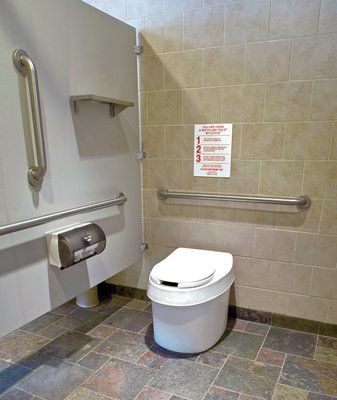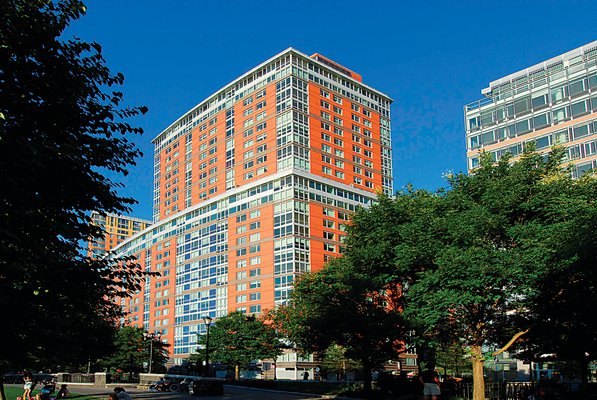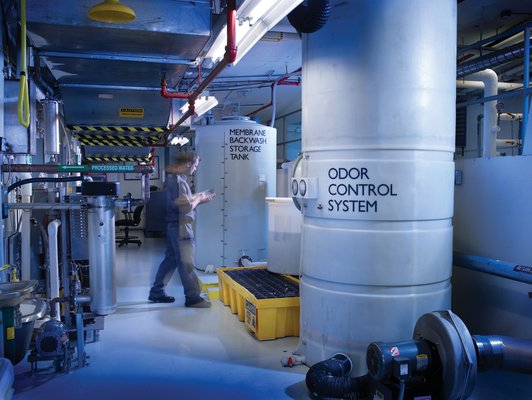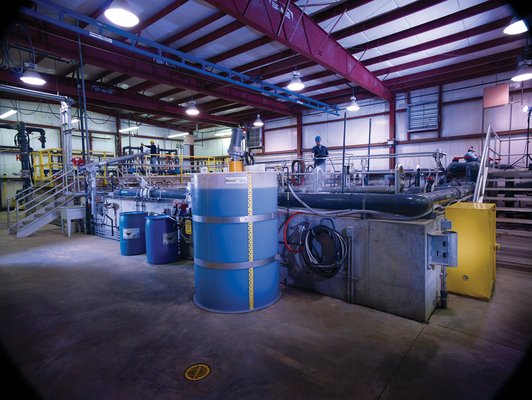
by Erin Wayman Thursday, January 5, 2012

A Clivus Multrum waterless toilet. Courtesy of Clivus Multrum

The Solaire, an apartment building in lower Manhattan, has a wastewater treatment plant in the basement. Creative Image

Recycled wastewater from Manhattan's Solaire apartment building is used in air conditioning, toilets and irrigation. American Water

Gillette Stadium, home of the New England Patriots, has its own water recycling plant. The recycled water is used to flush toilets. American Water
Have you ever thought about using your urine to fertilize your tomatoes and cucumbers? Full of nutrients like phosphorus, potassium and nitrogen, urine can work wonders in your garden. How about composting your feces — packed with rich organic matter just waiting to be decomposed — to help your rose bushes and oak trees grow? If you don’t use feces for composting, then it could be a source of natural gas and hydrogen for use as an alternative energy supply. Or perhaps you would be more comfortable with the thought of reusing the water you wash your clothes in to flush your toilets?
Grossed out? Join the club. Recycling plastic shopping bags and newspapers is commonplace, but many people are still skittish about reusing their most intimate wastes. A growing number of recycling-minded people are embracing the idea, however, and are starting to use such technologies in their homes and businesses. Wastewater treatment is an energy-intensive process, so with a dwindling freshwater supply and rising energy costs, thinking about unconventional ways to conserve water and energy — and save money — couldn’t come a moment too soon.
Nick Ashbolt wants to renovate his Cincinnati, Ohio, home to make it more like the one he has in Sydney, Australia. He plans to install a system of rainwater capture and vacuum-flush toilets (like the ones on airplanes) that use only a couple cups of water to flush the family’s waste into a tank in the basement, where, after a couple of years, a colony of earthworms will have transformed the material into fertile compost for use in the backyard.
This isn’t exactly the same setup he has in Sydney. The Ashbolt family composts their fecal waste there too, but they also use a urine-diversion toilet that allows for the separate storage of urine, which they then use to fertilize their citrus trees. But that kind of technology isn’t readily available in the United States, so for now, Ashbolt will have to make do with composting both feces and urine together.
As a senior research microbiologist for the U.S. Environmental Protection Agency’s Office of Research and Development and an adjunct professor at the University of Cincinnati, Ashbolt is hardly some hippie who has rejected society’s ways and is trying to live life off the grid. He has turned to alternative wastewater treatment because he is concerned that the dominant water treatment systems are not the most sustainable.
“The current large, centralized systems with one big pipe of water going to all purposes in the home and one large sewer taking it all back out … doesn’t make a lot of sense,” he says. “When we start looking at a large city like Sydney or a small regional development … often it’s more sustainable from the point of view of energy, environmental impact and health to have more decentralized systems.”
Decentralized strategies have several advantages over traditional water treatment systems. By treating and reusing wastewater onsite or locally, decentralized options can reduce water consumption and wastewater discharge, as well as trim the water industry’s energy use — and by extension, its carbon footprint. In addition to its water and energy savings, decentralized wastewater management can also provide resources, Ashbolt says. Wastewater contains nutrients for agriculture and raw materials to make energy — enough energy so that such systems would be net energy producers, not energy users.
In most water systems across the country, the water flowing through the tap has taken quite a journey to reach the kitchen sink. Water from a river, lake or other reservoir is pumped to a central treatment facility, where it undergoes numerous rounds of filtering and disinfection. From there, more pipes and pumps carry the treated water to homes and other buildings. In-home pipes then transfer the water to sinks, showers, bath tubs, toilets, washing machines and dishwashers.
Once the water is flushed down the toilet or spilled down the drain, it travels back to the wastewater treatment plant. Wastewater treatment plants tend to be built at the lowest end of town so that gravity, assisted by pumps, does most of the work transporting the wastewater. Upon arrival at the plant, the wastewater is screened for large solid materials and then usually undergoes a sequence of aeration and settling steps where bacteria naturally remove organic wastes. Finally, the treated water is typically disinfected to kill infectious microbes and then discharged back to the watershed.
The amount of energy consumed during this process is not trivial. In the United States, on average, about 5 to 8 percent of a region’s electricity goes to water treatment and transport, Ashbolt says. And some places require far more electricity to get the job done. California, for example, sends billions of gallons of water each year on a more than 800-kilometer-long journey from the northern part of the state to the populous, arid southern part, devoting about 20 percent of its electricity to water services.
Water and energy savings from decentralized options may not be immediate, but now is the perfect time to rethink water management in the United States, Ashbolt says, given that the country’s sewers and pipes are aging — and ailing. For example, last December, a water main broke in Bethesda, Md., flooding a street with millions of gallons of water and trapping drivers in their cars.
The job now is to figure out which technologies to use, where to use them, how to integrate them into the current system, and who will manage them. Regardless of the challenges, Ashbolt says, “decentralized systems in one form or another should be at least part of a suite of solutions.”
Decentralized wastewater treatment tends to have a bad reputation. The thought of onsite wastewater facilities conjures images of flies buzzing around a smelly, muddy, overflowing septic tank. “Historically, onsite systems — septic tanks — have not been maintained very well,” says Victor D’Amato, senior engineer of sustainable design services at Tetra Tech, an international science and engineering consulting firm based in California. “That’s why there’s this stigma of these types of systems being inferior to the big centrally controlled systems.”
In many rural areas, homeowners can’t connect to the centralized water system, relying on wells for drinking water and septic tanks for wastewater treatment. With a septic system, all wastewater in a house is piped to a large concrete tank buried in the backyard. In the septic tank, wastes naturally separate: Thick sludge sinks to the bottom and greasy scum floats to the top. As new wastewater flows into the tank, water in the tank is displaced and pushed through another pipe that empties into a drain field, where soil and microbes filter out impurities as the water seeps into the ground.
The decentralized system envisioned by Ashbolt ditches the traditional septic tank in favor of a system based on source-separation of waste. Such a system could have several configurations, but the point is to separate different wastes — greywater (shower, dish or laundry water, for example), yellow water (urine) and blackwater (feces/toilet water) — to allow for different forms of treatment and/or reuse.
Switching to such a system would require an overhaul of household plumbing, Ashbolt says. And although it doesn’t have to, it can require novel toilets — such as a toilet that separates yellow water from blackwater. In one scenario, for example, yellow water could be flushed and piped to an at-home tank, where it would be stored (allowing for natural disinfection) for future use. The stored urine could either be used at home in gardening, as is done in Australia, or collected periodically by a central authority for later use in agriculture. Such a system exists in Stockholm, Sweden, where large tankers come around every six months to retrieve stored urine that is later used in agriculture. Alternatively, Ashbolt says, yellow water could be flushed into a sewer-like distribution system that carries the urine to nutrient-recovery sites, where it could be turned into a solid for easier transport to agriculture.
Meanwhile, blackwater could be flushed down a separate low-flow vacuum-flush toilet and then piped to flow through a system that brings the waste to energy-recovery stations, where it could be used as an alternative source of energy via the methane and hydrogen gas it emits. This sort of energy and nutrient recovery is “a radical way of solving a lot of our current problems,” Ashbolt says. But it requires Americans to rethink their views on “waste.” And figuring out the best — and cheapest — infrastructure design for these practices still needs a lot of research, he says.
Ashbolt’s plans to deal with yellow water and blackwater may seem futuristic, but the third component of his vision — water recycling — is already creeping into wastewater treatment systems across the world.
For his home in Sydney, Ashbolt is considering installing a greywater recycling system that treats the water for reuse in flushing toilets, washing clothes or irrigating gardens. Reusing greywater, he says, saves 70 percent of the water going to houses and leaving via the sewer.
Again, installing such a system requires some new plumbing: Toilet water is separated from all other sources of water in the house. In one possible system, the non-toilet water that goes down the drain is pumped through a refrigerator-sized sand or carbon filter, which might sit in a basement or right outside of a house. Next, the filtered water passes through either a chlorination or ultraviolet disinfection system before returning to the house for non-drinking-water purposes. Such a system does run on electricity, so homeowners would have to hook them up to the grid. Alternatively, Ashbolt says, photovoltaic solar roof panels could easily supply the necessary energy — and thus cut down on carbon emissions, as well as the homeowner’s electric bill.
Unlike nutrient and energy recovery, reusing water is a decentralized strategy that water utilities are considering, and in some cases, already using, says Mark LeChevallier, director of Innovation and Environmental Stewardship at American Water, the largest privately owned water utility in the United States, based in Voorhees, N.J.
“Only 1 percent of drinking water is actually used for drinking — you water your lawn, you wash your car, you wash your clothes [with it],” LeChevallier says. “You could use other sources of water for those purposes rather than high-quality drinking water.”
Of course, people do get squeamish when they think about washing their clothes in recycled wastewater. But with climate models predicting that water scarcity will be an increasing problem in the years to come, LeChevallier says people need to get over it. “People should start looking at this not just as a kind of yuck factor,” he says, “but really as a water resource. We need to use all resources in the most efficient way possible.” Already, about 1.7 billion gallons of water are reclaimed in the United States every day, LeChevallier says. “That will be a growing trend over the next decade.”
But LeChevallier doesn’t see water recycling happening at the level of the individual home — at least not yet. Only a few locations pipe reclaimed water into houses, he says. “In many other places, it’s used at locations that are high-volume water users,” such as public parks or golf courses. Car washes and firefighting are other examples, he says.
Right now, American Water provides recycled water for toilet flushing in commercial and industrial buildings, such as Gillette Stadium, home of the New England Patriots. The stadium’s wastewater treatment plant sits at the edge of the parking lot. A similar setup is installed at a shopping mall in Wrentham, Mass.
Water recycling and reuse is happening in some residential areas too. The Solaire, a high-rise apartment building in Manhattan’s Battery City Park with a Gold Certification from the U.S. Green Building Council’s Leadership in Energy and Environmental Design program, has just such a wastewater system in place. The Battery Park City Authority sought to build a model green building, and water sustainability was a crucial component, says Ed Clerico, president of Alliance Environmental, LLC, in Hillsborough, N.J., and the Solaire’s water resource engineer.
Prior to the Solaire, Clerico had never designed a water reuse system for a residential building. After assessing the site’s constraints, Clerico and his colleagues decided to take all of the building’s wastewater — separating wastewater sources was cost prohibitive, Clerico says — and divert the waste to an onsite treatment plant housed in the basement. The Solaire treats 25,000 gallons of wastewater each day, returning nearly half of that water to the cooling tower for air conditioning and the rest to the building’s toilets for flushing and the grounds for irrigation. The system requires “a relatively sophisticated treatment mechanism,” Clerico says, because a different level of filtering and disinfection is required for each form of reuse.
With its wastewater treatment system, the Solaire has reduced its water intake by 48 percent, compared to similar buildings, and its wastewater discharge by 56 percent. Reducing water intake not only reduces water consumption, but the combined reduction in water intake and water discharge also “enhances the function of the centralized system,” says Valerie Nelson, director of the Coalition for Alternative Wastewater Treatment based in Gloucester, Mass. By lightening the load of the municipal pipes and sewers, she says, it “allows you to have a more resilient centralized system.”
How this system affects energy consumption, however, is not yet clear, Clerico says. Although the Solaire uses 35 percent less energy than comparable buildings, its water reuse system was not designed to be an energy saver, he says. Under the sponsorship of the New York State Energy Research and Development Authority, Clerico is looking for ways to reduce the amount of power water recycling systems use. He’s also comparing the energy used in his systems to the energy that would be expended if the wastewater instead went through the municipal system — or if the municipal system treated water to the high-quality level needed to allow for reuse.
Technology isn’t a problem when it comes to instituting decentralized wastewater treatment options throughout the country. “The science is really what makes it possible,” Nelson says. The main barriers are money and management.
Installing at-home wastewater treatment equipment is not cheap. Don Mills, sales director for Clivus Multrum, a Massachusetts-based manufacturer of composting toilets and greywater recycling systems, says installing such systems in a single house could cost $10,000 to $20,000. With those kinds of costs, Mills says, most of Clivus Multrum’s clients are commercial or public-use entities.
Ashbolt doesn’t think homeowners should have to bear the brunt of the cost when it comes to trying to make today’s wastewater management more sustainable. The government could incentivize such sustainable uses, he notes. In Australia, for example, where water is at a premium, local governments provide homeowners with incentives to install these sorts of technologies. The homeowner also owns the equipment and is ultimately responsible for maintaining it too. That’s been the downfall of many decentralized systems, D’Amato says, because homeowners often don’t understand how to maintain the system in the first place.
Another option is to change, or expand, the focus of water utilities to include managing decentralized systems, Ashbolt says. Under this scenario, all of the at-home equipment that Ashbolt has installed in his homes would be owned and maintained by a water utility, with a portion of each household’s water utility bill covering the cost of upkeep.
Some water utilities are moving in this direction. Virginia’s Loudoun County, which sits on the edge of the Washington, D.C., metropolitan area, relies on both a centralized and a decentralized water management system. In the rural part of the county, many residents have traditional septic tanks, but some subdivisions share mini-centralized systems called packaged plants that service a neighborhood.
Developers are responsible for building and initially paying for the infrastructure, but Loudoun Water takes over once the system is up-and-running.
Decentralized systems are a good water management solution for growing areas that lack established wastewater infrastructure, D’Amato says. “You can pay as you grow.” And decentralized systems can also be economically competitive with traditional municipal wastewater systems at the neighborhood-scale, Clerico says, where communities are using at least 200,000 gallons of water per day.
In Loudoun County, however, the packaged plants tend to suffer from a lack of economy of scale, says Todd Danielson, manager of community systems for Loudoun Water in Ashburn. To offset some of the costs, Loudoun Water charges developers a one-time fee to help pay for long-term maintenance. And it is considering selling recycled wastewater to a golf course for irrigation, Danielson says.
But current economic assessments fail to factor in life-cycle costs and the environmental impacts of water services, Ashbolt says. More detailed analyses, however, show that decentralized systems are among the most attractive options, he says.
The Solaire highlights another management style — and offers another example of where decentralized systems are most useful: Solaire’s wastewater treatment system is owned by the building’s developer and owner, the Albanese Development Corporation. But Clerico and his company manage the system. This type of decentralized system is a good option in an area of urban revitalization, Clerico says. Rather than update or modify existing infrastructure that doesn’t meet an area’s growing needs, building tailor-made wastewater systems on a smaller building-by-building, or neighborhood-by-neighborhood, basis allows for more managed growth, he says.
But these are still the early days of instituting more sustainable, decentralized wastewater management systems across the country. One potential issue will be wading through the various legal and regulatory channels, which can be a nightmare, D’Amato says. “It may not be defined who’s issuing the permits. Not to mention the fact that the more regulatory jurisdictions you’re dealing with, the more variability with what their requirements are,” he says. “There are no standards that are universally applicable. It varies from place to place.”
D’Amato and Clerico are hoping to clarify some of the confusion soon. Over the next year, the pair will lead a project funded by the Water Environment Research Foundation in Alexandria, Va., that will assess a sample of decentralized projects in urban and suburban areas from around the country to determine what makes for a successful system. The findings, D’Amato says, should help guide communities interested in decentralized wastewater management.
Integrating decentralized strategies into the mainstream to make water management more sustainable calls for a paradigm shift among those in the industry, Nelson says. But it also requires a change on the part of the consumer.
In the United States, many people take for granted that water will always flow through the tap once the faucet is turned on. Few people stop to think about where the water comes from or what it takes to deliver it home, LeChevallier says. “In many parts of the country, water is the cheapest utility. You pay more for your newspaper, your latte at Starbucks, your cable television,” he says. “The problem is water is too cheap, so people don’t value it. They don’t value the resource. They don’t value the embedded energy that it takes to deliver high-quality water.”
To change that attitude and get people comfortable with alternative wastewater treatment, Ashbolt says, the country needs a few “iconic” demonstration sites that show the value of decentralized systems. And, he says, “to show that this sort of redevelopment is safe and seems quite normal.”
© 2008-2021. All rights reserved. Any copying, redistribution or retransmission of any of the contents of this service without the expressed written permission of the American Geosciences Institute is expressly prohibited. Click here for all copyright requests.